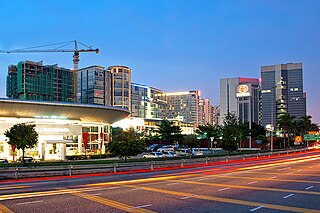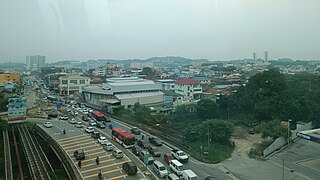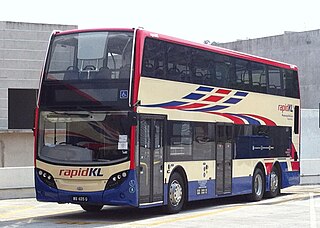
Putrajaya, officially the Federal Territory of Putrajaya, is the administrative centre of Malaysia. The seat of the federal government of Malaysia was moved in 1999 from Kuala Lumpur to Putrajaya because of overcrowding and congestion in Kuala Lumpur, whilst the seat of the judiciary of Malaysia was later moved to Putrajaya in 2003. Kuala Lumpur remains as Malaysia's national capital city per the constitution and is still the seat of the head of state and the national legislature, as well as being the country's commercial and financial centre.

Silat Melayu, also known as Seni Persilatan Melayu or simply Silat, is a combative art of self-defence from the Malay world, that employs langkah ('steps') and jurus ('movements') to ward off or to strike assaults, either with or without weapons. Silat traced its origin to the early days of Malay civilisation, and has since developed into a fine tradition of physical and spiritual training that embodies aspects of traditional Malay attire, performing art and adat. The philosophical foundation of modern Malay Silat is largely based on the Islamic spirituality. Its moves and shapes are rooted from the basis of Silat movements called Bunga Silat, and Silat performances are normally accompanied with Malay drum assembles.

Kuala Lumpur Sentral Station is a transit-oriented development that houses the main railway station of Kuala Lumpur, the capital of Malaysia. Opened on 16 April 2001, KL Sentral replaced the old Kuala Lumpur railway station as the city's main intercity railway station. KL Sentral is the largest railway station in Malaysia, and also in Southeast Asia from 2001 to 2021, before Krung Thep Aphiwat Central Terminal in Bangkok, Thailand was completed.

Bangsar is a residential suburb on the outskirts of Kuala Lumpur, lying about 4 kilometres (2.5 mi) south-west of the city centre. It is part of the Lembah Pantai parliamentary constituency. Bangsar is administered by Dewan Bandaraya Kuala Lumpur (DBKL), unlike other townships in the Klang Valley such as Petaling Jaya and Subang Jaya which have their municipal councils. Neighbourhood residents' associations and business councils play a part in communicating with the local authority, but they exercise no legal or administrative power. Malays make up most of the population at 61%, followed by the Chinese at 24%, Indians at 15%.

The Sepang District is a district located in the southern part of the state of Selangor in Malaysia. Sepang District covers an area of around 600 square kilometres, and had a population of 190,889 in the 2010 Census.

Subang Jaya is a city in Petaling District, Selangor, Malaysia. It comprises the southern third district of Petaling. It consists of the neighbourhoods from SS12 to SS19, UEP Subang Jaya (USJ), Putra Heights, Batu Tiga as well as PJS7, PJS9 and PJS11 of Bandar Sunway, the latter of which are partially jurisdictional within Petaling Jaya under the MBPJ. The city is governed by Subang Jaya City Council (MBSJ), which also governs other areas of the Petaling district, such as Puchong and Seri Kembangan. According to Subang Jaya City Council, Subang Jaya has a population of 968,930 in 2020, which makes it the sixth largest city in Malaysia by population.

Seri Kembangan, also known as Serdang, formerly known as Serdang New Village, is a town located in Petaling District, Selangor, Malaysia. It is located in between Kuala Lumpur and Putrajaya. The town is now a considerable city in size. It is located near the northern end of the PLUS Expressway Southern Route North–South Expressway Southern Route.

Bandar Baru Bangi is a township and satellite town of Kajang situated in Hulu Langat District, in southeastern Selangor, Malaysia.

The Damansara–Puchong ExpresswayDamansara–Puchong Expressway, abbreviated as LDP, is a 40.0-kilometre (24.9-mile) major controlled-access highway in the Petaling District of Selangor, Malaysia. The expressway runs in a north–south direction between Bandar Sri Damansara and Putra Permai, near Putrajaya, forming a major thoroughfare in the cities of Petaling Jaya and Puchong. A short east–west spur of the expressway connects Pusat Bandar Puchong to the suburb of UEP Subang Jaya.
The South Klang Valley Expressway, or SKVESouth Klang Valley Expressway, is an expressway in the southern part of Klang Valley, Malaysia's most densely populated region. This 51.7 km (32.1 mi) dual-carriageway provides links to the booming towns in southern Klang Valley, including the country's administrative capital, Putrajaya. South Klang Valley Expressway is the fifth east–west-oriented expressway in the Klang Valley after the Federal Highway, the New Klang Valley Expressway (NKVE), the Kuala Lumpur–Kuala Selangor Expressway (LATAR) and the Shah Alam Expressway (KESAS).

Puchong is a major town and a parliamentary constituency in Petaling District, Selangor, Malaysia.
Silat is a generic name for the martial arts of certain countries in Southeast Asia. There is untold number of Silat systems in Maritime Southeast Asia, with there being over 150 styles recognized styles of pencak silat in Indonesia, and more in aboard.

Bandar Kinrara is a township in Puchong, Selangor, Malaysia. The Ayer Hitam Forest Reserve is situated to its south. Island & Peninsular Berhad commenced the township development under Perumahan Kinrara Berhad in 1991. The only link road to the development then was via Jalan Puchong before entering Kinrara Army Camp road. Bandar Kinrara 1 was constructed for low-cost terrace houses before Bandar Kinrara 2 double storey terraces begun construction. The construction of Bukit Jalil Highway helped Bandar Kinrara to expand the development phase on both side of the highway. An underpass linked both sides of the development.

Rapid Bus Sdn Bhd is the largest bus operator in Malaysia operating mainly in urban areas of Klang Valley, Penang & Kuantan. As of February 2023, Rapid KL service brands unit of Rapid Bus, has operates 113 normal routes and also 69 MRT Feeder Bus routes, along with 8 Nadiputra routes in Putrajaya.
Tuan Haji Anuar bin Haji Abdul Wahab AMN was a grandmaster of Seni Gayung Fatani who, during his time, revolutionized the teaching and practice of silat in Malaysia.

The Bukit Jalil Highway, or Puchong–Sungai Besi Highway, Federal Route 217, is a major highway in Klang Valley, Malaysia. It is a toll-free and also a second highway after Shah Alam Expressway E5. It connects the Sungai Besi Expressway E9 near Selangor Turf Club in the east to Damansara–Puchong Expressway E11 near Puchong Jaya in the west. The highway passes Bandar Kinrara and Bukit Jalil.
Pulau Meranti is a village in Sepang District, Selangor, Malaysia.

Greater Kuala Lumpur is the geographical term that determines the boundaries of metropolitan Kuala Lumpur in Malaysia. Though similar to the term "Klang Valley", there remains a variation between the two. The metropolitan area covers 5,194.72 square km of land.
The Bangi-Putrajaya Expressway (BPE) is a new expressway under planning in Klang Valley, Malaysia. The 17-kilometre (11 mi) expressway connects Seri Kembangan, Kinrara, and Putrajaya. There are two sections of the expressway: the Kinrara-Putrajaya Section and Seri Kembangan.

Bandar Putra Permai is a rapidly developing new town in Seri Kembangan, Petaling District, Selangor, Malaysia. It encompasses areas from Taman Desaminium, Taman Equine, Taman Dato' Demang, Taman Suria Tropika, Taman Lestari Permai, Taman Prima Tropika, Alam Sanctuary, Taman Lestari Perdana, Pinggiran Putra, Pusat Bandar Putra Permai, Kota Perdana, Puncak Jalil and Taman Lestari Putra. Bandar Putra Permai is located near Seri Kembangan, Putrajaya and Puchong. Most of the residents are originally of Chinese descent, but an increasing number of Malays live there.















